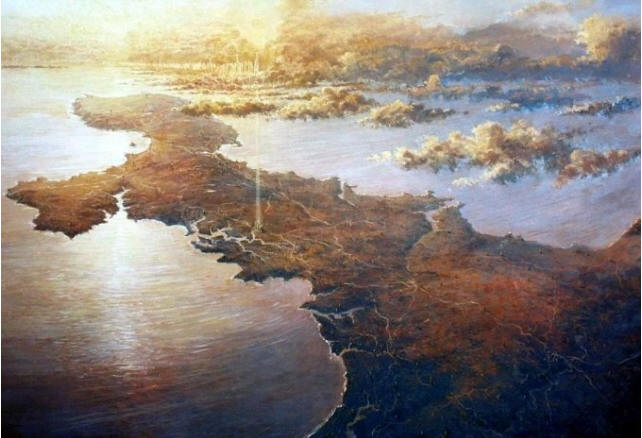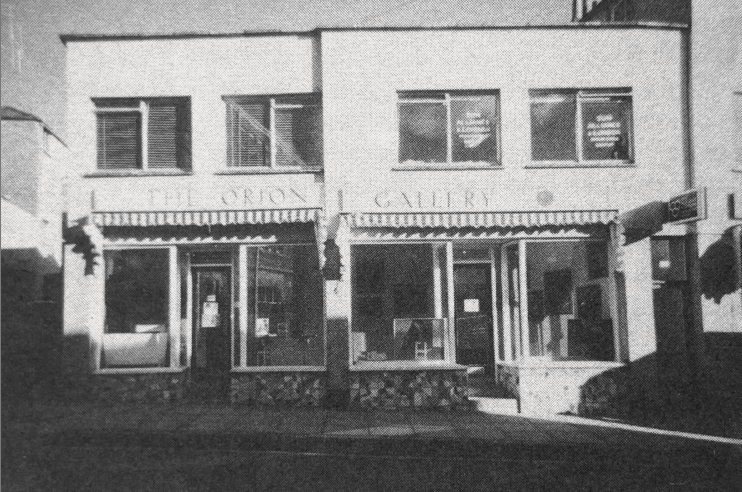|
|
| home | exhibitions | interviews | features | profiles | webprojects | archive |
|
John Halkes on the Orion Gallery, Mousehole, Newlyn, and Roger Hilton John Halkes was director and curator of Newlyn Art Gallery between 1974 and 1990. Interview Rupert White.
What brought you to Penzance and how did you end up setting up the Orion gallery? The children were small, I was in the Air Force and I'd finished my flying. I did three years command, and air-to-air refuelling, and I could see that it would be impossible to cope with two small children. RAF life was pretty tough… It had been a toss-up as to whether to go to art school or go into the Air Force. My parents weren't that well off, and the R.A.F. paid for me to stay at school and do A-levels and go to Cranwell R.A.F. College. I felt like I could go to art later. We needed somewhere to live, and my sister had a holiday cottage in Mousehole so we rented that for the winter while I got a job. We lived in Fairmaid's Cottage from 71 to 76 - opposite the historic manor of Keigwin House with its Elizabethan portico in the centre of the village. It was idyllic. A couple of artist-friends were neighbours. Anyone I might have heard of? Jack Pender and Joan Gilchrist. Autumn ‘71 is when we moved to Mousehole, and we put the children into primary school. Was the pottery there in Mousehole then? Yes, Biddy Picard’s pottery was going. And was the ARRA gallery, where Marlow Moss showed, still going? The ARRA had finished. Albert Reuss was then a widower. This lonely Viennese expat artist would roam the village, and I got to meet him. Where was ARRA? It was on the Salt Ponds in Mousehole. If you go down to the harbour, past Keigwin, then walk through the car park there is a row of cottages overlooking the sea, right on the sea’s edge. Albert Reuss had a big studio room there which he opened as the gallery. He closed that after Rosa died. So it had a short life.. Yes. In that period I was staying in another cottage over at Bojewan and I met this lady who said ‘what are you doing?’ ‘I’m applying for jobs in the arts. Just got back from a NT interview’. She said ‘I want to open a gallery. I’ve got the premises would you do it?’ I said ‘but you don’t know us from Adam’. She said ‘I never make a mistake about people’. So we opened the gallery February 1972 and called it ‘The Orion’. She was lovely, but scatty and deeply into property. Strangely enough when we opened the Orion in Feb '72 we could see the only other gallery in the area was the Wills Lane, in St Ives.
'Cornubia, Land of the Saints' (1980) John Miller
And by then lot of the artist were in the Newlyn area. There weren’t many in St Ives any more.. Yes. The magnetic pull goes backwards and forwards. St Ives had had its heyday earlier in the century. Post war… Paradoxically, with the Tate opening, it has hollowed out some of the local people who wanted to live and work there. One of the threads when we started The Orion we wanted to work with people who were good local artists. We started doing three-week solo exhibitions. We covered all the rent and outgoings we had one painting from each exhibition to go into stock. We built a programme up and I started visiting studios. It started to become very successful. In ‘72 ‘73 there was money around. Property was buying and selling, people were spending money on art, and I met John Miller, and his partner Michael (see photo).
Did he live at Lelant? Sancreed then. He moved to Lelant later and did those big beach scenes. He was chair of the NSA for a number of years. He and Michael started a framing business at Sancreed. One day John walked in and said ‘Roger Hilton is doing these amazing left-handed watercolours. His dealer doesn’t want to have anything to do with them. He doesn’t think they’re serious. Would you come and look at them with me because I think he wants a show?’. So I went with John to Roger and there he was lying in bed with these wondering daubings around. He was elderly and quite far gone by then, but they were brilliantly witty and interesting. He said do you think you can show these? ‘Yes, I think they’re wonderful!’ He said ‘Really?’ Waddington doesn’t like them at all’. I said ‘do you want a show’. He said ‘yes’. ‘Three week’s time?’ I could see he was pretty ill. June 1973. It sold incredibly well.
Did you get them all framed up? Michael Truscott framed them at Sancreed. They were tertiary Franciscans. I am in the lay order. So we shared art and religion. We had a wonderful private view.
And Roger made it down? He did. Then he was whisked off to the Abbey Hotel. He and Rose had a place of safety there with Jean Shrimpton. I had to say to the artist Roger Brennan that Roger Hilton was going to have his slot. Waddington pricked his ears up and in ‘74 Roger had the whole Serpentine, and Waddington was showing his stuff in Cork Street. Roger died shortly after that.
Ithell Colquhoun had a show at the Orion. According to Richard Shillitoe there was a show at Newlyn Orion in 1973. I remember the show at Newlyn, though not so much Orion. I met Ithell whilst living in Mousehole and I would have visited her in Mousehole.
The Orion gallery building isn’t there anymore is it? I think so. It was a hairdressers. Top of Morrab Road on the right. Above the Penzance Art School, but on the opposite side. It was opposite what in those days were the auction rooms. W.H. Lane's. That helped us, because in order to survive the winters we were looking at Newlyn School paintings coming through the auctions, and dealing. We’d have a stock of those. Newlyn School was beginning to become ‘dealer-worthy’ elsewhere through the country.
You’d have had also solo shows. So were there two rooms? No we knocked it into one. We would have the whole gallery for solo exhibitions but of course there was work stacked against the wall. You sell more art from the stacks!
Visitors feel like they’ve discovered it for themselves. It’s a successful way to sell! If it hasn’t sold, up the price and put it on the floor. People would come in waving fistfuls of £50 notes. I learned a lot.
The Orion Gallery at the top of Morrab Road c1973
The Arts Council were in a bind. They were funding the Penwith Gallery and Penwith Society of Arts, but before Peter Lanyon died he was bending their ear to fund Newlyn. Then when Peter died there was a lacuna, but there was still this lovely gallery, the Passmore Edwards. Ella and I had taken on an Arts Council touring exhibition at the Orion. It was a small but significant one they wanted to be shown, so they came naturally to us and said ‘can you do anything to help get Newlyn active again?’ So I wrote a paper on forming a new arts charity to encompass the Orion and Newlyn. The private gallery would wind up and be absorbed into Newlyn. We would enwrap the Newlyn Society Artists within that constitution. But it would be open throughout the year. It would take the touring exhibitions and the curator’s flat would be turned into galleries.
The flat was previously downstairs underneath the main gallery... Yes. SWA (South West Arts) was then emergent and Hugh Stoddart was the new arts officer. They liked the constitution, and I persuaded the NSA (Newlyn Society of Artists) to come on board. I explained that you stand to gain. The gallery would survive and you wouldn’t have to run it. And I’d guarantee you the same showing time, but we’d do it differently. And we’d put the place on the map… We formed a constitution, became a limited company and formed a council of management. I modelled it on the Arnolfini where Jeremy Rees had had a v successful start. We started in the Autumn of 1974. At the time the Newlyn School scholarship was quite ropey. Michael Canney had done an exhibition some years earlier but it didn’t have any academic input. So I had it in mind, as I saw things being catalogued as Newlyn School that I didn’t think were. The first exhibition at Newlyn Orion I showed Albert Reuss in the Orion and Karl Weschke on tour from the Arts Council. Karl absolutely fitted the bill because he lived at Cape Cornwall. He was national but local. Albert Reuss was an émigré who escaped to Britain. It amused me to have escaper from Hitler and a Hitler youth who had been reconditioned in a prisoner of war camp.
Is that how you managed the two galleries? Did they have separate exhibitions that related one to the other? They were complementary but not interactive. I remember Denis Mitchell and people like that coming in and being enthusiastic. Bryan Wynter too. He was lovely. Denis said ‘why are you opening, showing foreigners?' I said 'that’s a bit rich from a man from Wales!' Bryan was still at Zennor. And Margo Maeckelberghe had a studio up there. Terry Frost moved back later. I found him his studio. He came into the gallery a bit later, probably 1976, and said ‘I think I want to move back down do you know anywhere?’ I said ‘So and so is just moving out of Gurnick Studio, Tredavoe Lane in Newlyn…’ He went up, and he and Cath bought it. He was going back and forth to earn his keep. He had a lot of mouths to feed. I moved to live in Tredavoe and we became close friends and neighbours. Terry was lovely and full of stories. He showed at Newlyn too. As the years ticked by in those early days we were confronted with two things. I wanted to do a big Newlyn School touring exhibition and I wanted a scholarship. I found a young researcher who could put it together. Francis Greenacre at Bristol wanted to make his name. Bristol had some good Newlyn Stuff… We toured that. Plymouth and Bristol. Years later there was a rerun. That went to Plymouth, Bristol, Birmingham and London Barbican. There was that urge to get the art history sorted. But I also desperately wanted to build community in Newlyn. I wanted to get the locals back in because their art gallery had been left to them by the remarkable Passmore Edwards, but it had become a closed shop. You had to pay sixpence to come in, no children and no dogs. So we tore that down open. Free. Yours. Private views we asked all the locals to come in. It was hilarious...
see 'interviews' for pts 2 & 3
30.7.25 |
|
|


